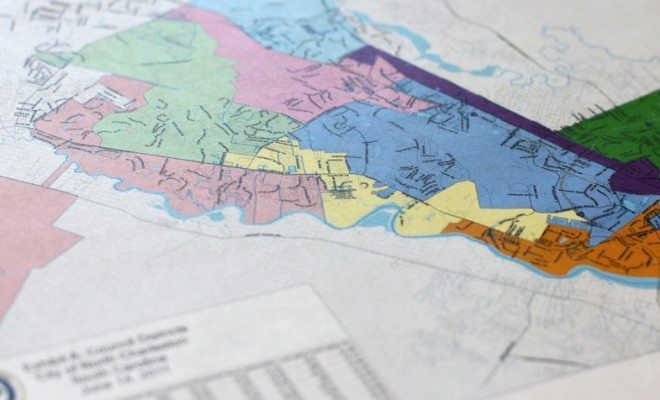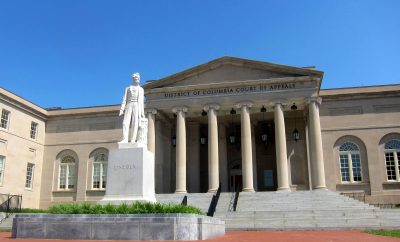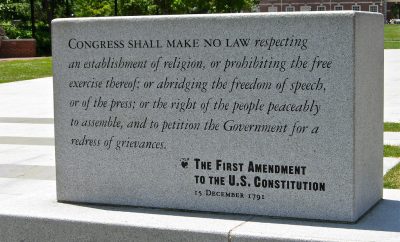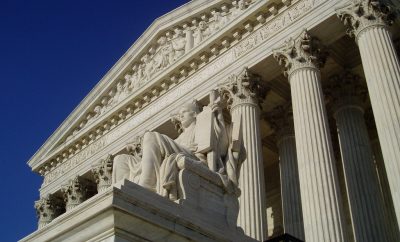 Image courtesy of [North Charleston via Flickr]
Image courtesy of [North Charleston via Flickr]
Politics
Gerrymandering: (Mis)Shaping America’s Vote?
It sometimes seems that we’ve been seeing the same faces in Congress for years. It feels like people such as Representatives John Boehner and Nancy Pelosi have been in office forever despite Congress’s dismal approval ratings. Why do the same people keep getting reelected, and why is it so hard to unseat incumbents?
One popular answer to that question is gerrymandering. Gerrymandering is a redistricting tactic that is used to increase the influence and power of a particular political party. It has been practiced since the country’s founding and has long been a controversial endeavor. Courts have battled with the legality of gerrymandering based on race, ethnicity, and other factors for decades. Read on to learn about what gerrymandering is, what role it plays in American politics, and the arguments against the practice.
What is gerrymandering?
Gerrymandering occurs during the drawing of Congressional district lines when attempts are made to give one political party or candidate an election advantage. These lines are drawn specifically to make reelections easier for a party, or give a party greater influence on other districts. The main intention of gerrymandering is to help one party win as many seats as possible, whether in Congress or in state elections.
Each state has its own process for drawing district lines, and it is the people in charge, typically state legislators, who draw and approve of new boundary lines. Each district has to have close to the same population and new lines are drawn due to population fluctuations, most typically after a census.
What’s in a name?
One of the first known occurrences of gerrymandering in the United States happened during the 1789 election of the very first U.S. Congress. The Anti-Federalists and founding father Patrick Henry controlled the Virginia House of Delegates, the legislative body that drew the boundaries for the state’s districts. They purposely designed Virginia’s 5th district in a way to keep James Madison, a Federalist, from winning the seat. However, their attempts were unsuccessful and Madison won the seat.
The term “gerrymander” came from the actions of the Governor of Massachusetts Elbridge Gerry in 1810. He was responsible for shaping new districts and the Boston Gazette commented that one of them was shaped like a salamander. Gerry’s name was combined with salamander and the term “gerrymander” was born.
Later, the Republican Party also used gerrymandering on a larger scale to acquire more states that were beneficial to the party. For example North and South Dakota, Republican friendly locations, were admitted as two separate states. That created more districts and senators for the Republicans than one state alone would.
Who draws the lines?
Each state has its own processes of redistricting. In 37 states, the state legislature governs the redistricting process and redraws the districts. It is usually passed like a piece of legislation and requires only a majority vote to pass. Because of this, the majority party in the legislature decides the district lines.
Of these 37 states, five use advisory commissions to help make fair district lines, but the ultimate decision is still up to the state legislature and it has no obligation to follow the commission’s recommendation.
In two states (New Jersey and Hawaii) the task of redistricting is up to political commissions, commissions comprised of certain elected officials. Typically there’s an equal amount of commissioners from each party and several commissioners from neither party. This ensures that no plan gets approved with only partisan support.
Four states (Washington, Idaho, California, and Arizona) use commissions made up of non-elected officials in an attempt to regulate the redistricting process and stop political influences altogether.
Seven states (Alaska, Montana, Wyoming, North Dakota, South Dakota, Delaware and Vermont) have no need for redistricting plans as they have only one congressional representative each, also know as “at-large” districts.
Is redistricting allowed to benefit one party?
The Supreme Court Case Davis v. Bandermer (1986) found that partisan gerrymandering violated the Equal Protection Clause of the Fourteenth Amendment. At the same time, no decision was made on what legal standards partisan gerrymandering claims could be made. This has made it difficult to make legal claims against alleged partisan gerrymandering and has allowed it to continue.
In the 2004 Supreme Court case Vieth v. Jubelirer the court, once again, could not determine how gerrymandering claims could be evaluated.
Four Gerrymandering Tactics
There are four common types of gerrymandering:
Cracking is when voters of one type are spread throughout many districts in order to prevent them from having a large voting bloc in any district. An example of cracking is when poor, urban voters are spread across districts where a large majority of the voters are rural. This prevents the urban voters from carrying much weight during elections. This is the most common type of gerrymandering.
Packing involves concentrating as many as possible of a single bloc of voters into one district to reduce their impact in other districts. An example would be putting most urban voters in one district and very few in other districts to give them only one district where they have a large presence. Many times this creates a majority-minority district, when one district is composed mostly of minority groups.
Hijacking is done when a state’s districts are redrawn after a census. Two districts are altered so that two incumbents of the same party are forced to run against each other. This guarantees that one of them will be voted out. The other district, with no incumbent, is then more easily won by the other party.
Kidnapping also occurs during redistricting, when voters of the incumbent’s party are moved out of the district to make reelection more difficult. For example, Democratic voters are moved out of an incumbent Democrat’s district and are replaced with Republican voters. This makes it difficult for the Democratic candidate to be reelected and easier for a Republican candidate to win.
What do gerrymandered districts look like?
Sometimes districts are shaped in very deformed ways. For example, check out this map by the United States Geological Survey that shows Illinois’ 4th Congressional District. It was designed to connect Chicago with other cities in order to make a heavily Democratic district.
How does gerrymandering impact elections?
Approval ratings for Congress have been below 20 percent for years, but that doesn’t mean that 80 percent of incumbents get ousted every election. Instead, it’s usually the opposite.
During the 2012 U.S. House of Representatives election, Democratic candidates received 59,318,160 votes and Republicans received only 58,143,273 votes (48.8 percent to 47.6 percent.) But Democrats won 201 seats and Republicans won 234 seats (44.9 percent to 51.7 percent). Despite the Democrats receiving more votes as a whole due to gerrymandering, Republican incumbents were mostly able to hold on to their seats. Overall roughly 90 percent of incumbents won reelection in 2012. On a state level, in 2010 Republicans won majorities in many state legislatures, and given the 2010 Census results, many districts were redrawn to benefit Republican incumbents.
Almost all districts have been gerrymandered to help incumbents get reelected. Most legislatures are typically comprised of both the majority and minority parties; they mutually agree to pack each district with their respective party’s voters in order to ensure reelection. Many of these districts are called 70/30 districts where two districts that are split 50/50 in party affiliation are each drawn 70/30 for a different party, guaranteeing each party wins one district. This is known as bipartisan gerrymandering, which protects both parties’ interests.
But sometimes a legislature is controlled largely by one party. They may redistrict in a cracking manner that prevents the minority party from having any significant influence in any district, making reelection very easy for the majority party’s incumbents.This is partisan gerrymandering which favors only one party.
How can boundary lines be decided objectively?
One of the biggest problems opponents have with gerrymandering is that the self-interested party is the one who oversees and commands redistricting. These parties are accused of only caring about aiding themselves and not their constituents. Opponents to gerrymandering have proposed different remedies to prevent gerrymandering.
Court approved redistricting would prevent specific party-favored redistricting and strike down gerrymandering plans. This would require all redistricting plans to be presented and approved by either state or federal courts. The Supreme Court has already ruled that if a plan violates the Voting Rights Act of 1965, a new plan must be presented that fixes the gerrymandering problem. If that plan also violates the law, a federal court could draw the plan.
Independent non-partisan commissions have been proposed to decide redistricting plans without political influence. Arizona, California and Washington have already adopted similar commissions.
Who agrees with gerrymandering?
Despite the disapproval by many of gerrymandering practices, there are some who argue for the practice.
By making it easier for incumbents to be reelected, there is less of a chance of a huge wave of change each election. If voter opinion changes from cycle to cycle (as it often does) there will not be huge shifts of changing leadership. If one party in the House is given an outstanding majority, any bill passed may be too polarizing to pass in the Senate, resulting in gridlock. Gerrymandering allows for gradual changes in representative composition.
Packing gerrymandering can also be used to prevent a minority group from being underrepresented. If a minority does not have enough voters in any district to have much influence in elections, then putting them in one district gives them a higher chance of electing someone based on their beliefs.
Conclusion
Party politics holds a very large role in how districts are drawn. While the United States’ democracy ensures that everyone will have the chance to vote on who represents them, gerrymandering is seen by some as an impediment to true representation. While gerrymandering can have some benefits, it is also responsible for keeping many disliked representatives in office. While there may never be a way to make sure that everyone’s vote makes a big impact, drawing districts fairly is an admirable goal toward which we should all strive.
Resources
Primary
NationalMaps.gov: Printable Maps
Additional
Study: Gerrymandering: Definition, History, Types & Examples
Politics & Policy: Gerrymandering – Proving all Politics is Local
Loyola Law School: Who Draws the Lines?
Gallup: 2014 U.S. Approval of Congress Remains Near All-Time Low
POLITICO: 2012 Reelection Rate: 90 percent
Newsworks: Boehner and House Republicans Lack Mandate to Oppose Obama








Comments